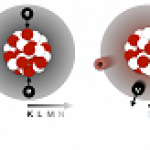Paper of the month: Dark matter detector observes rarest event ever recorded

May 10, 2019 by RebecaBV
In a paper published in Nature on the 24th of April, the XENON Col-laboration has detected a decay of 124XE at the experiment XENON1T for Dark Matter detection located at the INFN Gran Sasso laboratory in Italy.
Before this detection, it was predicted that the isotope's decay had a half-life (the time that it takes for half of the unstable nuclei in a sample to decay) many orders of magnitude bigger than the age of the universe, but there was no evidence of the process.
The XENON1T consists of a 3200-kilogram tank filled with extremely pure liquid xenon and located 1400 meters underground in order to shield the detector from cosmic rays. Although the experiment is intended to search for dark matter, it also detects any interaction with the xenon. In this way, the collaboration detected a double electron capture; two protons simultaneously catch two electrons, transforming into neutrons and emitting two neutrinos, an extremely rare process. By detecting this event, the researchers were able to calculate a half-life for the 124Xe of 1:8 x 1022 years, (about one trillion times longer than the age of the universe) making it the slowest process ever measured directly.
The detector is currently being upgraded to boost the sensitivity. This could lead to findings of other exotic processes unrelated to dark matter, including neutrinoless double electron capture, a process that will establish that the neutrino is a Majorana fermion, and could help to establish it mass.
.png)
Figure 1: Illustration of a double electron capture, two protons simultaneously capture two electrons and convert into neutrons emitting in the process two neutrinos. X-rays are emitted when the electron vacancies are filled.
References
[1] E. Aprile et al. [XENON Collaboration], \Observation of two-neutrino double electron capture in 124Xe with XENON1T," Nature 568 (2019) no.7753, 532 doi:10.1038/s41586-019-1124-4 [arXiv:1904.11002 [nuclex]].
by Sergio González and Simon King


